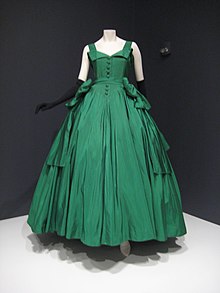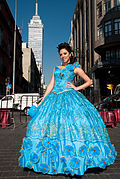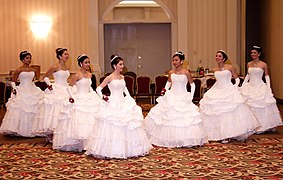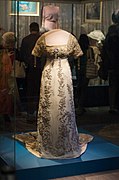What will MOST LIKELY happen to the green satin gown?

A ball gown, ballgown or gown is a type of evening gown worn to a ball or a formal result. Most versions are cutting off the shoulder with a low décolletage, exposed arms, and long bouffant styled skirts.[ane] Such gowns are typically worn with a opera-length white gloves and vintage jewelry or couture, stole (a formal shawl in expensive fabric), cape or cloak in lieu of a coat. Where "state decorations" are to be worn, they are on a bow pinned to the chest, and married women wear a tiara if they take one. Although synthetic fabrics are now sometimes used, the most common fabrics are satin, silk, taffeta and velvet with trimmings of lace, pearls, sequins, embroidery, ruffles, ribbons, rosettes and ruching.[1]
History [edit]
1850s [edit]

In previous years, the same type of dress might have been chosen an evening dress, having very like features; low-cut neckline, a tight bodice, a large skirt and (sometimes) bare artillery.[2] The ball gown at this time had similar features, a full skirt supported by a petticoat, a tight waist accomplished by a corset or bodice with a stay to keep the subject area upright and with perfect posture, off the shoulder style and with bare arms.[3]
In the coming years, the introduction of the sewing auto changed the dress marketplace. Middle-class people could at present produce their ain dresses and with more than quality and efficiency than before when they were made by hand. Upper form members of gild might even so have had their dresses fabricated by a designer but with the plow effectually time decreased.[3] Around this time was also the introduction of chemical dyes.[3] This dramatically inverse the range of colors that dresses could be produced in. This fourth dimension was encompassed within the Romantic period, which coincided with the Victorian era. During this time the crinoline was introduced likewise as demure sleeves, which puffed up around the arm.[iii]

1860–1864 [edit]
Skirts had developed an overall bell shape but with extra fullness at the back.[three]

1865–1867 [edit]
Skirts lost their front end shape and were altered to lay more flat against the body while the sides and back gained fullness with pleating techniques. Often a long train was attached to the back of the skirt.[3]
1868–1878 [edit]
For the adjacent ten years the fullness in the back of the skirts increased further with the employ of the bustle.[3]



The wearing apparel on the left is a skillful representation of a gown from circa 1880.
1878–1884 [edit]
The hurry went out of style because information technology was not needed anymore for the fullness in the back of the wearing apparel. The material instead was gathered and fell downwards the back which concluded with a long train.[3]
1890–1900 [edit]
The hourglass shape emerged which was known for a narrow waist. It was accomplished past having a cone-shaped skirt that was narrow at the waist and gained fullness near the bottom.[3]


After the terminate of World War Two, in 1947, Christian Dior introduced his "New Expect" of nipped-in waistlines and full skirts.
1950s [edit]
Previously, brawl gowns were worn for private events and parties, just in the mid-20th century, individual events turned into public ones. As the century progressed, traditional events became less of import while ones like charity events took their place. In 21st century culture, galas and red carpet events are showcases for extravagant gowns to exist in the public eye. In Britain, when Elizabeth II terminated formal court events in 1957, the more public events, similar a clemency brawl, arose in popularity considering they were open to anyone who could afford to buy a ticket.[4]
Designer dresses were typically part of a designer's collection, having them altered for the wearer. Designers demand to know where a dress will exist worn to avoid two people from matching.[4] But if the original wearer decides to article of clothing the wearing apparel to another event afterwards, the possibility of matching is increased. In modern times, designers must empathize that their pieces of work will be criticized and also praised as a upshot of the internet and paparazzi.
Gallery [edit]
-

The gown on the far right is an accurate representation of 1 that would be worn in 1880.
-

"Hourglass" shape of 1900
Culture [edit]
The first forms of the 21st century term "debutante ball" or "cotillion" emerged in the mid 19th century with what was called a "coming out ball". These events were meant to testify off the women who were now of marriageable historic period. Traditionally the debutantes volition wear all white, but with varying styles of dress.[5] While the way of dress can vary, strapless and sleeveless variations are pop and are typically worn with white long gloves and can be accessorized with bouquets, and sometimes a fan. For most of the 19th century, a headdress with veiling was a popular style besides as a full train attached at the waist and in later years it would attach to the shoulders.
The traditional ideals of the debutante ball vary based on location in the The states. The debutantes in New Orleans could be seen wearing jeweled crowns and dresses with Medici collars with elongated trains. Texas has variations within its various regions. In Laredo, middle class debutantes article of clothing beaded suede garments. In San Antonio, the dresses are of elaborate colors and covered in beads of dissimilar designs. The beads add together extensive weight having some dresses weigh in at near 75 lbs.[5] Another coming of age consequence is the quinceañera, an upshot in Latin American cultures when a girl turns fifteen. Their gowns are often very brightly colored and resemble traditional ball gowns with very full ruffled or ruched skirts.[5]
-

-

-

-

Quinceanera photograph from Santa Fe, New Mexico
Outset Ladies Collection [edit]
In 1912, Helen Taft along with collection founders Cassie Mason Myers Julian-James, Rose Gouverneur Hoes, and the Smithsonian Establishment started the "Commencement Ladies Collection." It is customary for the first lady of the United States to donate the dress she wears to the inauguration brawl just it is not required. Every first lady is represented in the drove although they are not all inaugural dresses.[six] Mrs. Taft started this tradition when she donated her dress that she wore during President Taft'south inauguration. Typically the dresses were added to the collection later the first lady had left office simply in 1955 the public uproar to run across Mamie Eisenhower's inaugural apparel was so stiff that the Smithsonian changed their policy and added her apparel immediately, not waiting until she left office.[6]
Run into as well [edit]
- Ball (trip the light fantastic)
- Ballerina brim
- Crinoline
- Clothing terminology
- Dress codes
References [edit]
- ^ a b Hegland, Jane; Steele, Valerie (2010). The Berg Companion to Fashion. Bloomsbury Academic. pp. 45–47.
- ^ Hegland, Jane (2010). Evening Dress. Oxford: Bloomsbury Academic. pp. 265–267.
- ^ a b c d e f thousand h i Schwartz, Jessica (2016). Vesture and Style: American Way from Head. ABC-CLIO.
- ^ a b "Ballgowns: Virtually the Exhibition". Victoria and Albert Museum. 26 Nov 2012. Retrieved 1 November 2017.
- ^ a b c Haynes, Michaele (2010). The Berg Companion to Fashion. Bloomsbury Academic. pp. 204–206.
- ^ a b "- The Tradition of the Gowns". National Museum of American History. four April 2012. Retrieved 2017-11-16 .
Further reading [edit]
- Wallace, Ballad McD.; et al. (1986). Dance: a very social history. New York: The Metropolitan Museum of Art. ISBN9780870994869.
| | Wikimedia Commons has media related to Ball gowns. |
Source: https://en.wikipedia.org/wiki/Ball_gown






0 Response to "What will MOST LIKELY happen to the green satin gown?"
Post a Comment